
The Great Pacific Garbage Patch (GPGP), a vast dump of plastic swirling in the Pacific Ocean, is 16 times bigger than previously assumed, a new study released on Thursday said.
The accumulation of plastic garbage is bigger than France, Germany and Spain combined, the research published in the journal Scientific Reports said.
"We found about 80,000 tonnes of buoyant plastic currently in the GPGP," Laurent Lebreton, lead author of the study and member of The Ocean Cleanup project, said.
According to Lebreton, that amount is the equivalent weight of 500 jumbo jets. The plastic mass now stretches 1.6 million square kilometres and continues to grow.
Researchers used 30 vessels and two aircraft fitted with advanced sensors allowing them to produce 3D scans of the giant waste pile.
The build-up of plastic refuse contains an estimated 1.8 trillion pieces of plastic, threatening marine life.
The vast majority of pieces are smaller than half a centimetre, small enough to end up in the food chain when swallowed by fish, affecting seals, sharks, polar bears and even humans.
Turtles, large fish and other species also get caught in and killed by bigger pieces in a process known as "ghost fishing".
People's single-use culture is one of the leading causes of plastic pollution in the oceans, Lebreton said.
"It's not so much this or that sector or region; it's the way we consume and live - single-use plastics, throw-away society," he said.
"We need to take some serious action on that front. We'll solve this problem on a global scale."
The Ocean Cleanup project, a Dutch startup founded in 2013 by 18-year-old Boyan Slat, aims to scoop up half the debris within five years.
To do this, the research team, consisting of 75 people, plans to construct dozens of floating barriers.
The hope is wind and currents will move these barriers in and around the plastic patch, removing about 50 percent of the waste in five years.
Eight million tonnes of plastics enter the oceans every year, much of which has accumulated in five giant garbage patches around the planet.







